What is a Deep Plane Facelift?
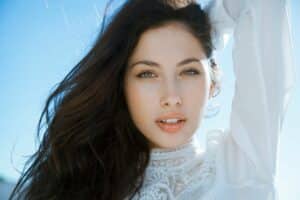
Some doctors shy away from the Deep Plane Facelift because of the more invasive nature of the procedure and the increased risk of nerve damage and other complications which might occur. Still, this technique has produced many satisfied patients because of the natural and long-lasting effects of deep mid-face plane lifting.
Deep Plane Facelift vs. Traditional Facelift
Unlike the traditional facelift, the deep plane facelift (Deep Plane Rhytidectomy) involves a deeper plane of dissection, allowing the surgeon access to the underlying muscle and soft tissue layer just below the skin. This includes the malar fat pads which begin to droop and flatten with age.
During the procedure the surgeon is constantly focused on the mid-face area including, the nose and upper lip to correct any issues caused by aging. With this technique the surgeon is also able to correct the deep nasolabial folds that form as the face loses volume due to the decreased production of collagen and elastin. These are the body’s foundational chemicals which give the facial skin its natural volume and elasticity.
Because the Deep Plane Facelift involves a deeper angle of “attack” there is an increased risk of facial nerve and tissue damage. It is an advanced and complicated surgical procedure that is best handled by an experienced and highly skilled surgeon. Even so, many surgeons view the procedure as a longer lasting alternative to the standard facelift because it targets age-related flaws centered in the mid-face area, an area often overlooked with other facelift techniques, while at the same time lifting the neck and jowls for a more youthful appearance. The Deep Plane Facelift tightens and rejuvenates the muscle-fascia layer and repositions fat tissue to achieve a true 3-dimensional result.
While the mechanics of the Deep Plane Facelift are more intricate by design, the results of the procedure are said to be superior than those of a standard facelift. If you have been considering facial rejuvenation surgery, the Deep Plane Facelift is just one of many options for you to discuss in consultation with a qualified plastic surgeon well-versed in the technique. To learn more about facelifts, visit medlineplus.gov.
Contact a Facial Plastic Surgeon for a Deep Plane Facelift Consultation
Dr. Philip Miller is a board certified facial plastic surgeon with offices located at 60 East 56th, Third Floor, New York, N.Y. Call (646) 791-3025 for a personal consultation or fill out our contact form.
Rhinoplasty Surgery for Older Patients
Am I too old for a nose job?
There is no age limit for having cosmetic nose surgery. The general rule is, if you’re in good health, you are likely a good candidate for surgery.
However, as patients get older, surgeons may be faced with increasing challenges that can affect the long-term cosmetic results for the patient.
Many patients from NYC choose to have cosmetic surgery done in their 40s and 50s, before the aging process produces significant changes in the appearance and basic structure of the nose. These patients are generally satisfied with the rejuvenating effect of rhinoplasty and in many cases, it is the fulfillment of a life-long dream to enhance their appearance.
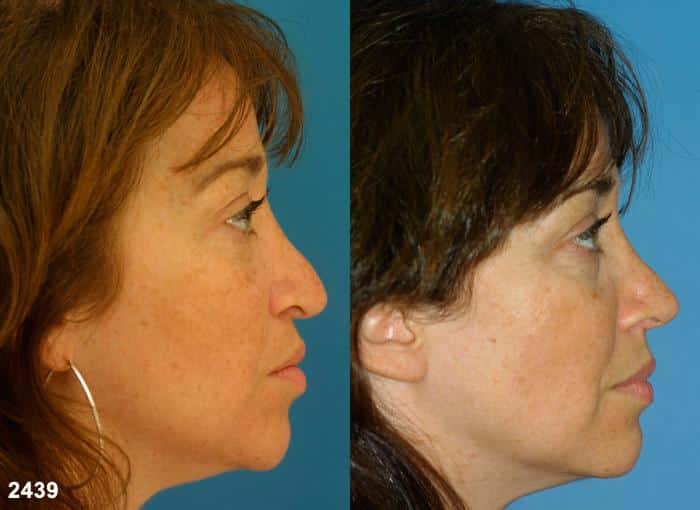
Is 40 too old for rhinoplasty?
78,054 total rhinoplasty procedures were performed on people aged 40-54 in 2021, according to the American Society of Plastic Surgeons (ASPS). As long as you are in good physical and mental health, you may benefit from the procedure. The best time to have a rhinoplasty is when you feel most confident in your decision and informed about the procedure. You must also be comfortable with your surgeon, who should guide you through the journey.
Nose Job at 50
As long as you are in good health and you have enough time on your schedule for a proper recovery, 50 is not “too old” for rhinoplasty. As a cosmetic procedure, rhinoplasty is intended to make the patient look and feel better about their nose, and a nose job can be tailored to a patient of any age. Just like any other patient, you will need a physical exam and be cleared by your doctor prior to surgery. Don’t let your age hold you back from consulting with a facial plastic surgeon in New York.

Rhinoplasty Over 50
The technical steps of performing a rhinoplasty in patients over 50 are similar to those for younger patients. Rhinoplasty at this age can even make you look more youthful, as changes may occur to the nose over time that contribute to an aged appearance. However, patients in this age group are more likely to have underlying conditions like hypertension and diabetes that could increase the risks associated with surgery.
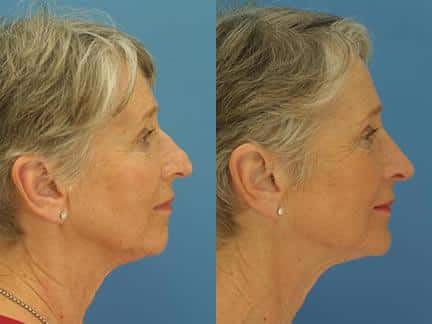
When a patient has reached the age of 60 and beyond, physiological changes in the nose demand a thorough evaluation by the performing surgeon to determine whether a favorable cosmetic result is possible. Any underlying health concerns must also be considered as well. Dr. Miller will discuss your medical history at length before surgery to ensure the procedure will be both safe and effective for you.
There may be a variety of pre-operative issues as well. For example, is the patient able to tolerate the anesthesia? What is the quality of the facial skin, nasal cartilage, and bone structure? Is there a severe nasal droop or significant changes in the nasal dorsum and nasal airways?
Years of exposure to the sun may have caused dramatic skin changes as well, affecting skin quality. The skin also grows thinner with age as there is less collagen and elastin produced by the body to give the facial skin its natural fullness and volume. As a result, older patients bruise more easily and healing takes longer to complete. There may be an increased risk of bleeding and scarring as well.
Dr. Miller will weigh your goals and expectations against the physical reality of surgery. Only then can he determine whether rhinoplasty is right for you. When you both have confidence in the safety and outcome of the procedure, everyone can be happy in the end.
Dr. Philip Miller is a board-certified facial plastic surgeon with offices located in Manhattan, New York, and New Orleans, Louisiana. Contact us online or call (646) 791-3025for a personal consultation.
Next, learn How we Can Fix a Twisted Nose
The Mini Facelift

In a traditional facelift, the incision typically runs from about the temples, in front of and around the ear, to behind the ear and ending in the lower scalp. Working through the incisions, the skin is separated from the deeper tissues. The skin is then re-draped and any excess skin is removed. It’s a more complicated procedure designed to reduce the appearance of extensive sagging and wrinkles of the lower face and neck.
Patients who opt for the Mini Lift are often in their 40s or 50 and don’t exhibit major signs of aging. The jawline may only show moderate drooping. There may only be a few shallow wrinkles and facial lines. The facial plastic surgeon’s views for the Mini Lift as a more localized approach to improve one’s facial appearance. It require much smaller incisions through which surgical tools are used to extract excess fat and reshape muscles so that a softening of facial lines and wrinkles is achieved quickly and with much less downtime required during the recovery process. The Mini Lift is also a less costly way for men and women to reduce minor sagging around the cheeks, neck, and jawline with minimal risk of complications during and after surgery.
Many patients prefer the Mini Lift because of its targeted approach, its cost effectiveness – roughly half that of a traditional facelift – its nearly immediate results, and its fast recovery period. Though your results will depend on a variety of factors, the Mini Lift is an excellent way to tackle the flaws and blemishes of early aging head on. A qualified facial plastic surgeon can help you decide which procedure is right for you and help you achieve the best facelift results. To learn more about the mini facelift, visit healthcare.utah.edu
Dr. Philip Miller is a board certified facial plastic surgeon with offices located at 60 East 56th, Third Floor, New York, N.Y. Call (646) 791-3025for a personal consultation
Next, learn about The Impact of Weight Loss after a Facelift.
What to Expect Immediately After Your Facelift
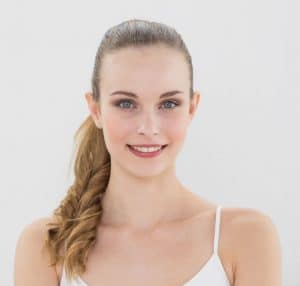
From the moment you wake up from the general anesthesia and open your eyes after your facelift surgery, you may not know quite what to expect. Expect to still be the same “you,” but the way you used to look, years ago, before the onset of facial lines and wrinkles and maybe that sagging neckline.
From that very moment until the facial plastic surgeon in New York removes your bandages for the last time, anticipation over what to expect and how you will appear may get the better of you at times. However, patience not only is a virtue; it’s the one virtue that will get you through the first few hours, days, and weeks after surgery.
Waking Up From the Anesthesia
If you had a traditional facelift procedure done, odds are the doctor recommended general anesthesia to ensure the best outcome. It’s normal to experience chills and nausea immediately after waking up. The discomfort may persist for an hour or so. Be prepared to feel groggy and out of sorts until the anesthesia wears off. If you had outpatient surgery, be sure to have a safe ride home.
Heading Home
When you do get home, your face may be wrapped up in thick bandages. There may have been one or more drainage tubes attached to make sure the blood drains properly, and your face most likely will feel tight and sore from the procedure.
Now for the challenging part: expect to see varying degrees of swelling and bruising one to three days after surgery. Don’t be alarmed. It’s normal for swelling and bruising to occur in and around incision areas and, in most post-op circumstances, it doesn’t indicate a problem or concern. However, you should call your surgeon right away if the swelling and bruising worsen significantly. Keep in mind also that your surgeon will be keeping close tabs on your recovery and scheduling follow-up visits.
A measure of pain and/or discomfort is to be expected after any surgery, including facelift surgery. You may have been prescribed pain killers. Many patients, however, say their recovery was so problem-free that they didn’t need pain medication.
Taking Care
Avoid medicines or food that may cause blood thinning as this will increase your risk of post-surgery bleeding. These include aspirin and garlic. Most importantly, try to stay active during your in-home recovery to keep the blood circulating. This will help to minimize the risk of developing blood clots in the legs and it will make sure that your incision areas are receiving fresh, well-oxygenated blood to promote the healing process. Of course, you will still need to rest and avoid overdoing.
Now for the good part: at the end of your recovery period expect to be pleasantly amazed at how well your incisions have healed and how much younger you look – not to mention the positive comments and compliments you’re likely to receive from your family, friends and co-workers. Expectation is the mother of all questions about facelift surgery. Your plastic surgeon of choice is best qualified to answer them.
Dr. Philip Miller is a board certified facial plastic surgeon with offices located at 60 East 56th, Third Floor, New York, N.Y. Call (646) 791-3025for a personal consultation or read more about facelift surgery.
Next, learn about The Mini Facelift
Factors that lead to Nose Surgery Satisfaction
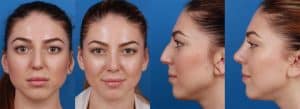
A few millimeters off target can significantly alter the intended effect and require revision rhinoplasty. The American Society of Plastic Surgery estimates 5 to 10 percent of all nasal surgeries are redone for various reasons, and that number is often higher for facial plastic surgeons who are less skilled.
Still, facial plastic surgeons report a high satisfaction rate among their patients and it all centers around the first, all-important consultation with the patient. It is far more than a routine “meet-and-greet” rap session. It’s the essential starting point whereby the plastic surgeon is able to determine exactly what the patient wants and the patient can understand what the doctor can deliver. Once a mutual understanding and practical guidelines are set, it makes for a happy and trusting relationship between doctor and patient.
Doctors note that a satisfied patient is one who has a good idea about what he or she is looking for in cosmetic nose surgery and is able to communicate his or her needs and desires in an honest and straightforward manner to the cosmetic plastic surgeon. A satisfied patient is also a stress-free patient. So, it’s up to the facial plastic surgeon to put the mind of the patient at ease with a thorough description of the surgery process from the first incision to the first week of the patient’s recovery period and beyond.
When the surgeon is fully aware of the patient’s reasons for being in the doctor’s office, the surgeon is then able to get a reliable sense of the patient’s short- and long-term goals. That, in and of itself, is essential to patient satisfaction. The patient’s goals, however, must be reasonable and both practical and efficacious – yielding the intended or desired results. Otherwise, the patient becomes a good candidate for a surgical do-over.
Moreover, a satisfied patient is one who is mentally and emotionally balanced as defined by prevailing societal norms. If the patient seems “out there” with his or her expectations or is showing signs of body dysmorphic disorder, that is a red flag for the plastic surgeon. The patients must also understand the potential complications that can occur.
Finally, many patients satisfied after having their first nose job are those who didn’t feel as though they were pressured into having the procedure by the surgeon. No one likes a high-pressure salesman. And it’s no different when it comes to cosmetic rhinoplasty. To learn more about rhinoplasty, visit ncbi.nlm.nih.gov
Your first consultation is the foundation for a successful and positive outcome, which usually translates into one happy customer.
Dr. Philip Miller is a board certified facial plastic surgeon with offices located at 60 East 56th, Third Floor, New York, N.Y. Call (646) 791-3025for a personal consultation or read more about rhinoplasty.
Next, read all about Rhinoplasty for Older Patients.
The Injectable Nose Job

* Each patient is unique and individual results may vary.
What if you could have the nose of your dreams but without the invasive surgery and post-op downtime? It’s possible with a popular in New York procedure known as the Injectable Nose Job, or 15-Minute Nose Job, which uses injectables and dermal fillers to get rid of unsightly nasal humps, bumps, drooping tips, and other minor flaws.
Unlike traditional rhinoplasty, an invasive surgical procedure, the injectable nose job involves the use of filler products like Restylane, Juvederm, and Radiesse. These products are used to change the appearance of the nose without the need for surgery.
The materials are injected into the nose in order to smooth out minor cosmetic flaws while rebuilding the nose and improving the overall appearance of the nose.
Why Choose An Injectable Nose Job
The effects are immediate. Minor cosmetic flaws such as a drooping tip, small depression, nasal hump or bump seem to vanish. The results are said to last for up to a year before they have to be repeated to maintain optimal results. The injectable nose job begins with the application of a topical numbing cream so that the patient experiences no pain during the procedure.
The benefits of the non-surgical nose job are that they involve less pain and there is no lengthy recovery period. The cost is also less compared with traditional Rhinoplasty. Moreover, the non-surgical treatments can be done in combination with nasal surgery so as to augment the results. Other benefits include the overall lack of bruising and swelling around injection sites and decreased risk of scarring associated with nasal surgery.
Thousands of patients each year choose to have an injectable nose job because they are on a limited budget or don’t require the full effect of nasal surgery. Nevertheless, the procedure is not for everyone. For larger cosmetic nose problems, the so-called 15-minute nose job is not a solution; surgical rhinoplasty is your best long-term solution. Furthermore, injectables cannot be used for reduction rhinoplasty but rather for augmentation rhinoplasty only, though nasal humps which may be reduced with nasal surgery can be disguised and made less obvious by filling in surrounding areas with injectables. Injectables can also pose a risk for future nasal surgery.
If a minor nasal hump, indent, or other imperfection has been bothering you, the injectable nose job is but one of many non-invasive options with short-term results. For more dramatic, long-term results, consider nasal surgery with the knowledge, help, and guidance of a qualified plastic surgeon.
Dr. Philip Miller is a board-certified facial plastic surgeon with offices located at 60 East 56th, Third Floor, New York, N.Y. Contact our office at (646) 791-3025 for a personal consultation.
Post-Facelift Makeup Tips

A facial plastic surgeon, such as Dr. Philip Miller in New York, will have given you important instructions on how to care for your skin so that the healing process can go forward without interruption or complications. This includes the use of makeup during the immediate post-operative period of your recovery.
Each person’s skin tone, color, and texture are different to work for facial procedures. Changes to the skin are common after surgery so a little bit of tweaking from your normal makeup routine may be necessary to ensure optimal results. Here are X helpful tips.
Get Rid of Any Old Makeup
It may have become dry or contaminated with bacteria or other makeup products. In fact, you should consider products that are specifically made to aid facelift patients, including products like The Big Coverup Kit or Cover Creme by Dermablend. Building a good foundation of makeup with good coverage will ensure you get the best results from your surgery.
Clean Thoroughly
Start with a good, gentle cleansing of the face from neck to forehead using a gauze pad or soft facial sponge. Work gently in and around the facial skin incisions to remove dirt and oils that may cause infection. Always use a gentle soap that won’t irritate your skin or incision sites.
Use Water-Based Makeup
Use water-based makeup during the first three weeks of your recovery period. It’s easy to wash off should you encounter any skin problems or reactions. Oil-based makeups are not as easily removed and can clog pores. If your skin is on the sensitive side, use hypo-allergenic makeup that won’t cause irritation or inflame incisions that have not yet healed.
Get a Different Foundation
Always use a foundation that is one shade lighter than the surrounding skin as the skin may tend to darken with swelling and bruising.
Use Color Theory To Hide Imperfections
Green-colored makeup is best for balancing out reddened areas, and blue eye shadows helps minimize red skin around the eyes. If your skin tone is naturally ruddy, don’t use makeups of similar color.
It may be especially challenging covering large swollen or bruised areas. Fortunately, special corrective cosmetics are available that are designed to give complete coverage of these problem areas.
Your surgeon will have other helpful makeup tips and techniques so that your wounds will heal properly and make sure that your results are truly stellar. To learn more about facelift, visit medlineplus.gov
Dr. Philip Miller is a board certified facial plastic surgeon with offices located at 60 East 56th, Third Floor, New York, N.Y. Call (646) 791-3025for a personal consultation.
Next, learn What to Expect Right After Your Facelift.
What Do Bridalplasty and Rhinoplasty have in Common?

Many brides-to-be have decided that looking their best also warrants cosmetic surgery and, in particular, nasal surgery. In these cases, they’re finding that an upcoming wedding is a great opportunity to correct a longstanding nasal flaw that may have made them self-conscious. Perhaps that flaw is a nasal hump or flared nostrils, or a hooked nose that detracts from the overall facial appearance.
For these reasons more than a few brides-to-be have opted for nasal surgery in New York in as little as a month before they say “I do.”
Plan for Recovery
Nasal surgeons warn that there is about a 10 percent risk that a nasal “touch-up” may be necessary if the nose does not heal as expected. Furthermore, swelling can take as much as a year or more to fully resolve after surgery, though most noticeable swelling has faded within six months’ time. Therefore it is more realistic for the bride to have the surgery at least six to nine months ahead of time, so that the nose will have plenty of opportunity to heal and assume its new shape and dimensions.
The whole idea of “Bridalplasty,” as the pre-nuptial nose job is sometimes informally called, is to reshape the nose in such a way that it enhances and harmonizes with other key features of the face. Rhinoplasty involves the surgical reshaping of the nasal bones and nasal cartilage in order to achieve optimal results that fit the goals of the patient. The vast majority of nose jobs are successful the first time around. In a few cases, however, the procedure has to be repeated to “get it right.” That’s the bad news for brides dreaming of the “perfect” wedding-day nose.
Choose Your NYC Surgeon Carefully
The good news is that surgical errors and complications are minimal when the bride takes the time to shop around for the most qualified, experienced, and skilled nasal plastic surgeon. Just as she would do to plan ahead for her wedding, the bride needs to plan ahead for the rhinoplasty procedure, allowing herself plenty of time to make a full and successful recovery.
First, though, she must consult with the surgeon to find out whether she is, in fact, a good candidate for rhinoplasty. It’s a deeply personal decision for the bride to make and one the surgeon must never take lightly.
If you’ve been considering cosmetic nasal surgery for your all-important wedding day, talk to a qualified plastic surgeon about the risks and benefits of rhinoplasty.
Dr. Philip Miller is a board certified New York facial plastic surgeon with offices located at 60 East 56th, Third Floor, New York, N.Y. Call (646) 791-3025 for a personal consultation.
Next, learn about The Factors that Lead to Nose Surgery Satisfaction
Choosing the Right Shape for Your New Nose

The plastic surgeon in New York factors in a number of variables in the design of the surgical procedure. Existing skin, cartilage, and bone structure all determine how much nasal shaping is possible within the limits of reason, surgical skill, and technology.
For example, while surgery to reduce a large nose is very common, there is a limit to just how small the nose can be made. The underlying framework of bone and cartilage can be reduced in size, but the skin itself is often left untouched. Furthermore, the nose must work with the other facial features. If the nose is too small for the chin or cheeks, the overall facial appearance will be unbalanced. Despite these limitations, a skilled surgeon can create many pleasant and subtle adjustments to the existing nose structure that will leave you feeling satisfied. The results of cosmetic nasal surgery are never rushed or drastic. They bring out the best of the nose you have in near perfect harmony and balance with other facial features.
Shape and Looks
When choosing the right shape of your new nose, always strive toward a natural look that maximizes the size, shape, and proportion of your natal nose. A female patient, therefore, will desire more feminine results compared to a male patient, including a straight nasal bridge, a slight, youthful “lift,” and a nose that is neither too long nor too pointed, and one with slender nostrils.
You may have been inspired by the wonderful results of a friend or celebrity who had a nose job. Keep in mind, however, that the plastic surgeon is not a miracle worker. He or she can only work within the normal parameters of the nose nature gave you. Any “copycat” surgery to mimic the results of a popular actor may appear artificial and out of balance with your facial makeup. However, pictures of noses that you do like can be helpful during the consultation process to communicate what it is that you do and do not like, but keep an open mind to what your doctors recommends.
Most of all, make sure your surgeon is board certified, well experienced in rhinoplasty, and able to deliver results. Look at his or her before and after pictures and check out their credentials. While it may not be possible or best for you to receive just about any nose, a skilled plastic surgeon can help you make the most of the nose you were born with.
Let a New York Plastic Surgeon help you with your Nose
Dr. Philip Miller is a board certified facial plastic surgeon with offices located at 60 East 56th, Third Floor, New York, N.Y. Call (646) 791-3025for a personal consultation.
Next, read all about what Bridalplasty and Rhinoplasty Have in Common.
Minimizing Bruising After Rhinoplasty
The fear associated with a traditional nose job (rhinoplasty) has, for some patients, a lot to do with the degree of bruising that appears after the surgery. The Internet is filled with post-op pics of rhinoplasty patients with anything from mild yellow discoloration to full-out black eyes, and this can be a bit disconcerting for someone considering surgery. Though some lucky patients in New York enjoy a speedy recovery with little or no bruising around the incision areas or eyes, the reality is that bruising and black eyes are normal effects of the procedure and are to be expected to some degree.
Post-rhinoplasty bruising can have a lot to do with the techniques used during surgery. Was osteotomy performed and were the nasal bones broken? Was there soft tissue dissection involved? If the answer to both questions is yes, then be prepared to experience some swelling and bruising and maybe a pair of raccoon eyes as your body recovers from the trauma of surgery.
The bruising and black eyes which often occur post-rhinoplasty involves the discoloration of undersurface skin with blood that leaked from damaged blood vessels. The degree of bruising and discoloration depends on the type of nasal procedure as well as the skill of the surgeon doing the procedure. Skilled cosmetic nasal surgeons will always prepare their patients for potential risks and complications during the recovery process. Their advice and practical tips are worth putting into practice to promote a full recovery and optimal results.
Tips for Reducing Bruising
- Ice or a cold compress is an absolute must during the first 48 hours after surgery. The cold will minimize swelling and bruising. Administer the ice or cold compress every 30 minutes for at least several days following surgery.
- Pineapple juice containing bromelain is also useful as an anti-inflammatory for post nasal surgery patients.
- Things to avoid post-surgery include aspirin, alcohol, and herbal supplements, which thin the blood and increase the risk of bleeding. As a rule of thumb, refrain from using these substances at least seven days before and after you have the surgery. This will also minimize the risk of anything going wrong on the operating table.
- Also, be sure to steer clear of questionable surgery recovery products. These may or may not work, and may even make matters worse. Always consult your doctor’s opinion trying out any new products.
No rhinoplasty patient wants to see his or her surgical results go to waste. The advice of a qualified plastic surgeon will go a long way in making sure you get your money’s worth and the nose you’ve been dreaming about.
Dr. Philip Miller is a board certified New York facial plastic surgeon with offices located at 60 East 56th, Third Floor, New York, N.Y. Call (646) 791-3025 for a personal consultation.
Next, learn How to Choose the Right Shape for Your New Nose
